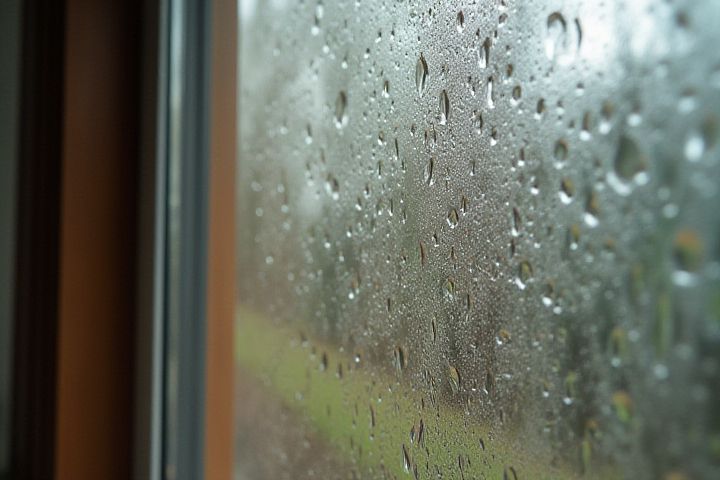
High humidity in a house is primarily caused by various factors such as poor ventilation, excessive moisture generation from cooking, showers, and drying clothes indoors. Leaks in plumbing or roofing can introduce unwanted water, further raising indoor humidity levels. Additionally, weather conditions like heavy rain or high outdoor temperatures can contribute to increased humidity when windows and doors are left open. The presence of indoor plants can also add moisture to the air, depending on their number and size. To manage humidity, consider using dehumidifiers or ensuring proper airflow with fans and exhaust systems.
What Causes High Humidity In A House
Poor ventilation
Poor ventilation is a primary cause of high humidity levels in your home, leading to trapped moisture and increased humidity percentages often exceeding 50%. When air circulation is inadequate, areas like bathrooms and kitchens retain moisture from activities such as cooking or showering, contributing to dampness and potential mold growth. Inadequate airflow also prevents the removal of humid air, making it difficult for dehumidifying systems to function effectively. Ensuring proper ventilation through exhaust fans, open windows, or air exchange systems can significantly reduce indoor humidity levels and improve overall air quality.
Leaking pipes
Leaking pipes can significantly elevate humidity levels in your home, often going unnoticed until damage occurs. When pipes develop leaks, water escapes into the air and surrounding materials, increasing moisture content and creating an ideal environment for mold growth. This excess moisture can lead to numerous health issues, including respiratory problems and allergies. Regular inspections and timely repairs of plumbing systems can help maintain optimal humidity levels, ideally between 30% and 50%.
High outdoor humidity
High outdoor humidity is primarily caused by geographical factors, such as living in coastal areas or regions with abundant water bodies that increase moisture levels in the air. Seasonal weather patterns, especially during the summer months, often lead to elevated humidity as temperatures rise and evaporation rates increase. Natural events like heavy rainfall or storms can introduce substantial moisture into the atmosphere, which can seep into your home if proper insulation and ventilation are lacking. You may also notice that indoor humidity rises if your home is poorly ventilated, allowing outdoor moisture to linger indoors, leading to discomfort and potential mold growth.
Indoor plants
Indoor plants contribute significantly to high humidity levels in your house through a process called transpiration, where they release moisture from their leaves into the air. In densely planted environments, larger quantities of water vapor can increase relative humidity by as much as 10-20%. Certain plants, like peace lilies and ferns, are particularly effective at raising moisture levels due to their expansive foliage and high water needs. By maintaining a balance of 30-50% humidity, these plants not only thrive but also create a more comfortable living space for you.
Cooking activities
Cooking activities can significantly elevate the humidity levels in your home, particularly when boiling water or preparing meals that involve steam. For example, boiling pasta can release approximately 1-2 liters of water vapor into the air, increasing indoor moisture. The temperature at which food is cooked also plays a role, as higher temperatures can trap more moisture in the atmosphere. Ensuring proper ventilation, such as using range hoods or opening windows, can help mitigate these humidity spikes.
Showers and baths
Showers and baths significantly contribute to high humidity levels in your home by releasing large volumes of water vapor into the air. A typical 10-minute hot shower can emit approximately 1-2 liters of steam, raising indoor humidity levels drastically. If your bathroom lacks proper ventilation, this moisture can linger, creating an environment that encourages mold growth and can damage paint and drywall over time. Installing exhaust fans or opening windows during and after bathing can effectively reduce humidity levels and improve air quality.
Wet clothes drying indoors
Drying wet clothes indoors significantly elevates indoor humidity levels, as the moisture from the fabric evaporates into the air. This process can add several liters of water to your home's atmosphere within just a few hours, depending on the amount of laundry. High indoor humidity, often exceeding 60%, can lead to mold growth, increased allergen levels, and discomfort. To mitigate this issue, consider using a dehumidifier or ensuring proper ventilation in the drying area.
Inadequate insulation
Inadequate insulation can significantly contribute to high humidity levels in your house by allowing warm, moist air from outside to infiltrate the interior. Poorly insulated walls, attics, and basements can lead to condensation on cold surfaces, creating an ideal environment for humidity accumulation. Homes with insufficient insulation may experience temperature fluctuations that exacerbate moisture retention, increasing the risk of mold and mildew growth. Proper insulation can effectively manage indoor air quality by reducing humidity levels and enhancing overall comfort.
HVAC system issues
High humidity in a house often stems from inefficient HVAC system performance, particularly due to poorly maintained air conditioning units. When HVAC systems are not properly sized or lack regular maintenance, they can fail to effectively remove moisture from the air, leading to elevated humidity levels. A clogged condensate drain or dirty air filters can exacerbate this issue, restricting airflow and preventing proper dehumidification. You can reduce indoor humidity by ensuring your HVAC system is regularly serviced and that components are cleaned or replaced as needed.
Rainwater seepage
Rainwater seepage significantly elevates humidity levels in a house by introducing excess moisture into the indoor environment. When rainwater infiltrates through cracks in the foundation, walls, or roof, it can saturate building materials such as wood and drywall. This absorbed moisture then evaporates into the air, increasing relative humidity, which can reach levels above 60%, creating an uncomfortable atmosphere and fostering mold growth. Ensuring proper drainage, sealing leaks, and maintaining gutters are crucial steps in managing humidity and mitigating the effects of rainwater seepage.
